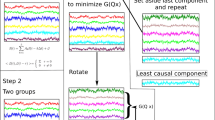Abstract
We describe a novel method for the analysis of multivariate time series that exploits the dynamic relationships among the multiple signals. The approach resolves the multivariate time series into hierarchically dependent underlying sources, each driven by noise input and influencing subordinate sources in the hierarchy. Implementation of this hierarchical decomposition (HD) combines principal components analysis (PCA), autoregressive modeling, and a novel search strategy among orthogonal rotations. For model systems conforming to this hierarchical structure, HD accurately extracts the underlying sources, whereas PCA or independent components analysis does not. The interdependencies of cortical, subcortical, and brainstem networks suggest application of HD to multivariate measures of brain activity. We show first that HD indeed resolves temporal lobe ictal electrocorticographic data into nearly hierarchical form. A previous analysis of these data identified characteristic nonlinearities in the PCA-derived temporal components that resembled those seen in absence (petit mal) seizure electroencephalographic traces. However, the components containing these characteristic nonlinearities accounted for only a small fraction of the power. Analysis of these data with HD reveals furthermore that components containing characteristic nonlinearities, though small, can be at the origin of the hierarchy. This finding supports the link between temporal lobe and absence epilepsy. © 2001 Biomedical Engineering Society.
PAC01: 8719Nn, 0545Tp, 0250-r, 0230Lt
Similar content being viewed by others
REFERENCES
Akaike, H. A new look at statistical model identification. IEEE Trans. Autom. Control 19:716–723, 1974.
Bell, A. J., and T. J. Sejnowski. An information-maximization approach to blind separation and blind deconvolution. Neural Comput. 7:1129–1159, 1995.
Bollerslev, T. Generalized autoregressive conditional heteroskedasticity. J. Econometr. 31:307–327, 1986.
Borg, I., and P. Groenen. Moder Multidimensional Scaling: Theory and Applications. New York: Springer, 1997, pp. 132–134 and 399-402.
Ding, M., S. L. Bressler, W. Yang, and H. Liang. Short-window spectral analysis of cortical event-related potentials by adaptive multivariate autoregressive modeling: Data processing, model validation, and variability assessment. Biol. Cybern. 83:35–45, 2000.
Gersh, W. and J. Yonemoto. Parametric time series models for multivariate EEG analysis. Comput. Biomed. Res. 10:113–125, 1977.
Granger, C. W. J. Investigating causal relations by econometric models and cross-spectral methods. Econometrica 37:424–438, 1969.
Kaminski, M. J., and K. J. Blinowska. A new method of the description of the information flow in the brain structures. Biol. Cybern. 65:203–210, 1991.
Kay, S. M. Modern Spectral Estimation: Theory and Application. Englewood Cliffs, NJ: Prentice-Hall, 1988, pp. 141 and 142.
Lee, D. D., and H. S. Seung. Learning the parts of objects by non-negative matrix factorization. Nature (London) 401:788–791, 1999.
Mirsky, L. An Introduction to Linear Algebra. New York: Dover, 1990, pp. 236–247 and 306-311.
Mitra, P. P., and B. Pesaran. Analysis of dynamic brain imaging data. Biophys. J. 76:691–708, 1999.
Press, W. H., S. A. Teukolsky, W. T. Vetterling, and B. P. Flannery. Numerical Recipes in C: The Art of Scientific Computing. New York: Cambridge University Press, 1992, pp. 412–413 and 463-466.
Repucci, M. A., N. D. Schiff, and J. D. Victor. Implications for the dynamics of temporal lobe seizures derived from multivariate autoregressive analysis of electroencephalograms. Proceedings of the Society for Neuroscience 29th Annual Meeting, Miami, FL (242.9), 1999.
Schiff, N. D., D. R. Labar, and J. D. Victor. Common dynamics in temporal lobe seizures and absence seizures. Neuroscience (Oxford) 91:417–428, 1999.
Schiff, N. D., J. D. Victor, and A. Canel. Nonlinear autoregressive analysis of the 3/s ictal electroencephalogram: Implications for underlying dynamics. Biol. Cybern. 72:527–532, 1995.
Schiff, N. D., J. D. Victor, A. Canel, and D. R. Labar. Characteristic nonlinearities of the 3/s ictal electroencephalogram identified by nonlinear autoregressive analysis. Biol. Cybern. 72:519–526, 1995.
Steriade, M., P. Gloor, R. R. Llina´s, F. H. Lopes da Silva, and M.-M. Mesulam. Report of IFCN committee on basic mechanisms: Basic mechanisms of cerebral rhythmic activities. Electroencephalogr. Clin. Neurophysiol. 76:481–508, 1990.
Victor, J. D., and A. Canel. A relation between the Akaike criterion and reliability of parameter estimates, with application to nonlinear autoregressive modeling of the ictal EEG. Ann. Biomed. Eng. 20:167–180, 1992.
Wei, W. W. S. Time Series Analysis: Univariate and Multi-variate Methods. New York: Addison-Wesley, 1990, 478 pp.
Yoshioka, K., F. Matsuda, K. Takakura, Y. Noda, K. Imakawa, and S. Sakai. Determination of genes involved in the process of implantation: Application of GeneChip to scan 6500 genes. Biochem. Biophys. Res. Commun. 272:531–538, 2000.
Yule, G. U. On a method of investigating periodicities in disturbed series with special reference to Wolfer's sunspot numbers. Philos. Trans. R. Soc. London, Ser. A 226:267–298, 1927.
Author information
Authors and Affiliations
Rights and permissions
About this article
Cite this article
Repucci, M.A., Schiff, N.D. & Victor, J.D. General Strategy for Hierarchical Decomposition of Multivariate Time Series: Implications for Temporal Lobe Seizures. Annals of Biomedical Engineering 29, 1135–1149 (2001). https://doi.org/10.1114/1.1424914
Issue Date:
DOI: https://doi.org/10.1114/1.1424914




